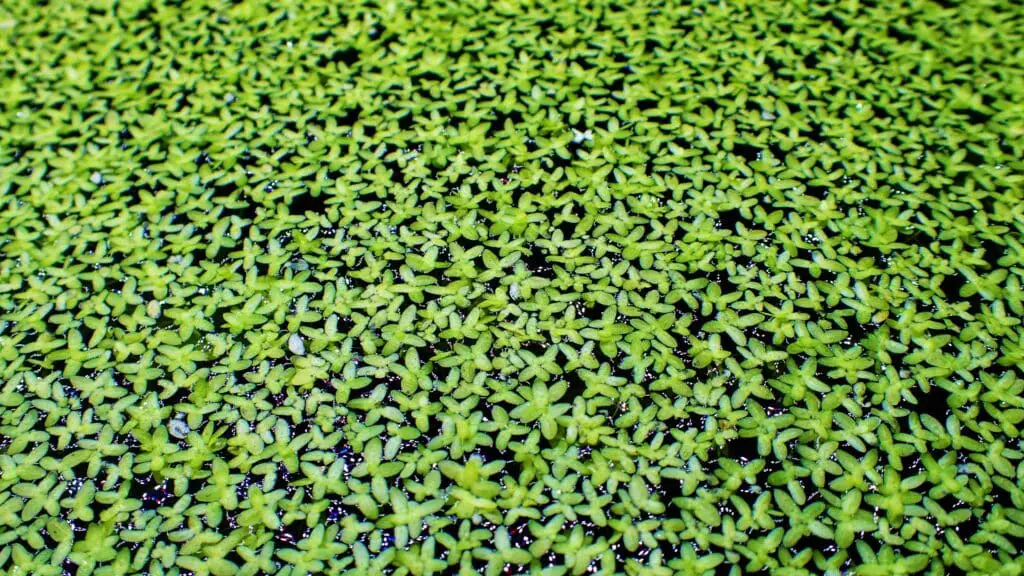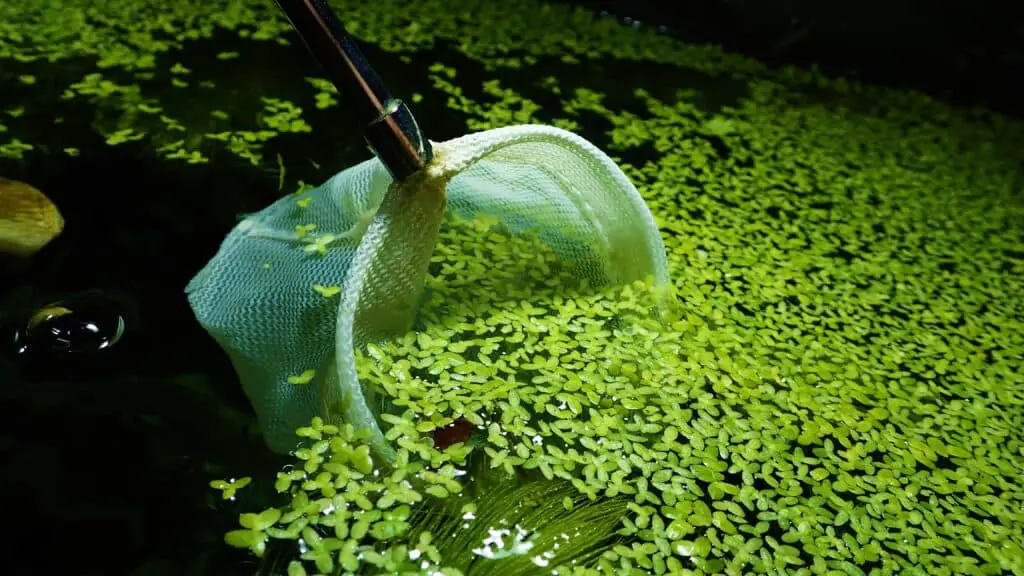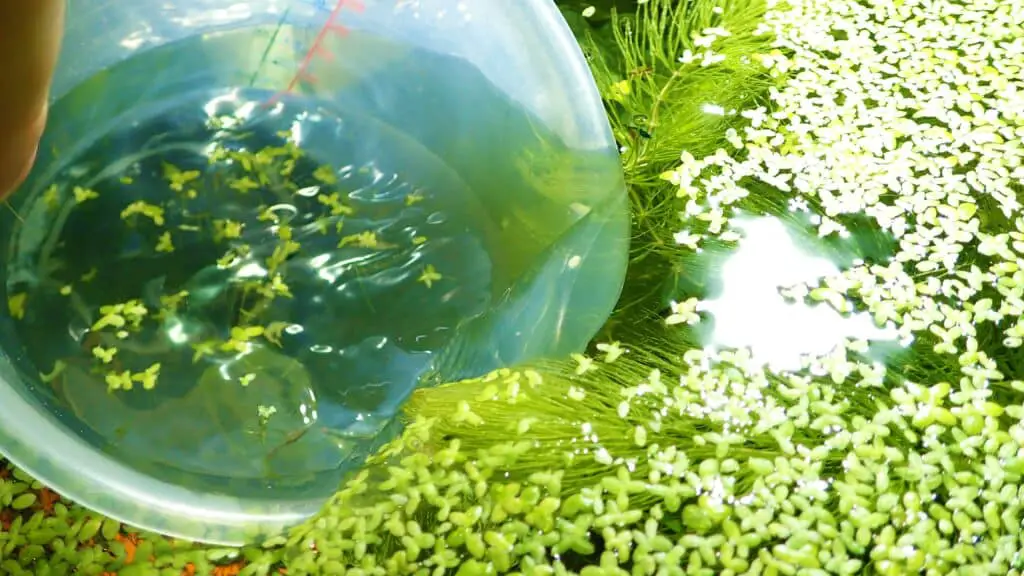Ever found yourself standing by your beautiful pond on a sunny day, a cold lemonade in hand, only to have your peaceful moment shattered by the sight of a green, leafy invasion? Yes, I’m talking about duckweed. This tiny aquatic plant, as cute as it sounds, can quickly turn your serene water feature into a green soup. So, how does one tackle this verdant villain and reclaim their pond?
The key to getting rid of duckweed is a combination of physical removal, controlling nutrients in the water, and introducing duckweed predators.
Picture this: It’s been 15 years since I first laid eyes on my own little slice of paradise – a quaint pond nestled in my backyard. Over the years, it’s been a source of joy, a place of tranquility, and, unfortunately, a battlefield against duckweed. This persistent little plant, with its rapid growth rate, has been a thorn in my side, or rather, a weed in my pond, for as long as I can remember.
I’ve tried everything – from manually scooping it out with a net (a great arm workout, by the way) to introducing hungry koi fish that feast on the stuff. I’ve even explored the world of aquatic herbicides, though with caution, as I didn’t want to harm my other aquatic plants or the local frog population.
Through trial and error, and a lot of patience, I’ve managed to keep the duckweed at bay. But let me tell you, it’s been quite the journey. So, buckle up, dear reader. I’m about to take you on a deep dive into the world of duckweed control, sharing the wisdom I’ve gained from my 15-year-long battle with this stubborn aquatic invader.
Duckweed The Good
Duckweed is a tiny aquatic plant offers numerous benefits when incorporated into a shrimp or fish tank,or pond making it an ideal choice for many aquarists. As a fast-growing plant, duckweed provides several advantages that contribute to a healthy and thriving ecosystem within the aquarium.
First, duckweed serves as an excellent natural filter, absorbing excess nutrients such as nitrates, phosphates, and ammonia from the water. These nutrients can accumulate in the tank due to fish waste and uneaten food, leading to unhealthy water conditions. By absorbing these harmful substances, duckweed helps maintain water quality and supports a healthy environment for shrimp and fish.
Another significant advantage of duckweed is its ability to provide shade and shelter for the tank’s inhabitants. The floating plant’s dense growth creates a comfortable habitat, allowing shrimp and fish to feel secure and less stressed. This is particularly beneficial for shrimp, as they tend to be more sensitive to stress and require hiding spots to thrive.
Moreover, duckweed acts as a supplementary food source for the aquarium’s occupants. Some fish, such as goldfish and koi, are known to graze on duckweed, while certain shrimp species, including cherry shrimp and Amano shrimp, can also feed on it. This additional food source helps support the overall health and well-being of the aquarium inhabitants.
Oxygenation is another essential aspect of a thriving aquatic environment, and duckweed contributes to this process as well. Through photosynthesis, duckweed generates oxygen, which is then released into the water. This oxygen supplementation is particularly important in heavily stocked tanks, where maintaining adequate oxygen levels can be challenging.
Furthermore, duckweed’s rapid growth rate can be advantageous for aquarists who are seeking to control algae growth. By outcompeting algae for the same nutrients, duckweed helps reduce the likelihood of algae blooms, which can lead to an unsightly appearance and water quality issues.
Lastly, the presence of duckweed in a shrimp or fish tank creates a more natural-looking environment. The floating plant adds visual interest and contributes to the overall aesthetic of the tank, making it a more pleasant and enjoyable display for both the aquarist and observers.

Duckweed The Bad
While duckweed possesses numerous advantages for ponds, shrimp and fish tanks, it is essential to acknowledge some potential drawbacks arising from its presence in the aquarium. These negative aspects should be considered when deciding whether to incorporate duckweed into a specific tank setup.
One of the primary concerns associated with duckweed is its rapid growth rate. While this can be advantageous in some situations, such as controlling algae growth, it may also lead to overgrowth within the tank. This excessive proliferation can cause several issues, including reduced light penetration to other aquatic plants, which may struggle to receive sufficient light for photosynthesis. In extreme cases, other plants may suffer and die off due to the lack of light.
Another issue related to duckweed overgrowth is its potential to clog filters and other aquarium equipment. If not properly managed, the floating plant can accumulate and obstruct filtration systems, leading to reduced water flow and compromised water quality. This situation may require additional maintenance and cleaning, which can be time-consuming and labor-intensive for aquarists.
The invasive nature of duckweed can also pose a problem for aquarists who wish to maintain a specific aesthetic or plant arrangement in their tanks. Due to its rapid growth and ability to spread across the water surface, duckweed can quickly overtake other plants and dominate the tank. This outcome may not be desirable for those who prefer a more curated and controlled appearance in their aquariums.
Furthermore, removing duckweed can be challenging, especially if it has been allowed to grow unchecked. It may require considerable time and effort to eliminate the plant from the tank entirely. Additionally, the tiny size of duckweed makes it easy to accidentally reintroduce it to the tank, even after the aquarist believes it has been eradicated.
Lastly, while duckweed can serve as a supplementary food source for some fish and shrimp species, it may not be suitable for all aquarium inhabitants. Some fish, particularly those adapted to a carnivorous diet, may not consume duckweed at all. In such cases, the plant may not provide the desired nutritional benefits and could instead contribute solely to the issues discussed earlier.

How to remove Duckweed?
While duckweed offers numerous advantages for an aquarium, there may be times when an aquarist needs to remove it due to overgrowth or other concerns.
In such cases, it is crucial to employ efficient and effective techniques to eliminate duckweed without harming the tank’s inhabitants or disrupting the ecosystem. Here are some methods to consider when removing duckweed from a shrimp or fish tank.
- Netting with a fish or shrimp net
 : One of the simplest and most straightforward methods for removing duckweed is using a fish or shrimp net. Carefully skim the water surface with the net, capturing the floating duckweed in the process. Be gentle to avoid disturbing the tank’s inhabitants or accidentally catching fish and shrimp. It may be necessary to repeat this process several times to remove the majority of duckweed. To prevent reintroduction, ensure that you rinse the net thoroughly before using it again in the tank.
: One of the simplest and most straightforward methods for removing duckweed is using a fish or shrimp net. Carefully skim the water surface with the net, capturing the floating duckweed in the process. Be gentle to avoid disturbing the tank’s inhabitants or accidentally catching fish and shrimp. It may be necessary to repeat this process several times to remove the majority of duckweed. To prevent reintroduction, ensure that you rinse the net thoroughly before using it again in the tank. - Using a hair comb: Another creative and effective method to remove duckweed is by using a fine-toothed hair comb. Glide the comb gently across the water surface, allowing the teeth to catch and collect the floating duckweed. Be cautious not to dip the comb too deep into the water, as this could disrupt the tank’s environment or harm its inhabitants. Once the comb is full of duckweed, carefully remove it from the tank and dispose of the plant material. Repeat this process as necessary until the desired amount of duckweed has been removed.
- Creating a duckweed trap with a container: You can use surface retention to move duckweed into an empty void like a soda bottle by gently pushing the container into the water, let the duckweed flow into the container and remove.
TOP TIP
When netting out duckweed from a pond or aquarium, let it sit in a white container filled with water for a little while before you dispose of it or add it to another tank, this allows any animals you have unwittingly captured to swim down to the bottom of the container making it easy for you to see them.
Simple net them back out of the bucket and into the tank or pond they came from.

Don’t Use Herbicides to Kill Duckweed in an Aquarium
Using herbicides or chemical treatments to control duckweed growth in ponds or aquariums is strongly discouraged, as it can devastate the overall ecosystem. While herbicides may seem like a convenient solution for eliminating unwanted plants, the potential risks far outweigh the benefits in an aquarium setting. Here are some reasons why aquarists should avoid using herbicides to kill duckweed in an aquarium.
- Toxicity to fish and shrimp: Herbicides are designed to kill plant life, but they can also be toxic to fish, shrimp, and other aquatic organisms. When introduced to an aquarium, these chemicals can cause stress, illness, and even death among the tank’s inhabitants. The risk of harm is particularly high for sensitive species that are more susceptible to changes in water chemistry and quality.
- Adverse effects on beneficial bacteria: An aquarium’s nitrogen cycle relies on beneficial bacteria to break down harmful substances like ammonia and nitrite, which are produced as a result of fish waste and decaying organic matter. Herbicides can disrupt this delicate balance by killing off these essential bacteria, leading to a spike in toxic substances and a decline in water quality.
- Disruption of the ecosystem: In addition to harming fish, shrimp, and beneficial bacteria, herbicides can also disrupt the overall balance of the aquarium ecosystem. Killing duckweed and other plants may result in a decrease in oxygen production, which is crucial for maintaining a healthy environment. Additionally, the sudden die-off of plant life can cause an increase in organic matter, further contributing to a decline in water quality.
- Difficulty in controlling dosage: Determining the appropriate dosage of herbicides for an aquarium can be challenging, as it requires precise calculations based on the tank’s size and water volume. An incorrect dosage may not only be ineffective in killing the duckweed but could also lead to even more harmful consequences for the tank’s inhabitants.
- Persistence of chemicals: Once introduced to an aquarium, herbicides can persist in the water for extended periods, continuing to affect the tank’s ecosystem and its inhabitants long after the initial application. Even after water changes, residual chemicals may remain, causing ongoing harm to fish, shrimp, and plants.
Instead of using herbicides to control duckweed growth in an aquarium, consider employing natural and non-invasive methods, such as those mentioned earlier in this conversation.
Learn to Read Your Duckweed
Duckweed can serve as a useful indicator of water quality and overall aquarium conditions, providing valuable insight into the health of your tank’s ecosystem. By closely observing the appearance and behavior of duckweed, aquarists can glean important information about their tank’s water parameters, nutrient levels, and even the feeding habits of shrimp. Here are some examples of how to interpret duckweed’s appearance and growth patterns to better understand your aquarium’s conditions.
- Dark green growth: Duckweed that is a lush, dark green color may indicate high nutrient levels in the water, as the plant is effectively absorbing and utilizing the available nutrients. This can be a sign that there is an excess of nitrates, phosphates, or other nutrients in the tank, potentially due to overfeeding or inadequate filtration.
- Yellowing or pale leaves: Yellowing or pale duckweed leaves can signify low nutrient levels in the aquarium or a deficiency in specific nutrients, such as iron. This may be an indication that you need to supplement your tank with additional nutrients or adjust your fertilization regimen to ensure that your plants receive the necessary nourishment for healthy growth.
- Duckweed roots: The length and appearance of duckweed roots can provide valuable information about shrimp feeding habits in your aquarium. Very long roots may suggest that you are overfeeding your shrimp, as the duckweed is compensating for the lack of nutrients available in the water. Conversely, very short roots or even a complete absence of roots may indicate that the shrimp are underfed, leading them to consume the duckweed roots in search of sustenance.

Conclusion
While duckweed can present challenges when it grows unchecked in a shrimp or fish tank, its numerous benefits often outweigh these drawbacks. This versatile aquatic plant provides multiple layers of protection and support for your aquarium ecosystem, including acting as extra filtration, offering additional surfaces for biofilm growth, and serving as a supplementary food source for tank inhabitants.
However, it is essential to manage duckweed growth to prevent it from overtaking the entire water surface, which can lead to decreased light penetration, filter clogging, and other issues. Incorporating duckweed removal into your regular aquarium maintenance routine can help maintain a balanced and healthy environment for your aquatic pets.
I hope you found this article informative and insightful, providing you with valuable information on the advantages and potential challenges associated with duckweed in a shrimp or fish tank. With proper care and management, duckweed can be a beneficial addition to your aquarium ecosystem.
If you need any help please feel free to contact me here or on the group facebook page.
Happy shrimp keeping!
FAQ
Q. How do you get rid of duckweed fast? A. The quickest way to remove duckweed is through physical removal using a rake or a net. Gather the plants together and remove them from the water’s surface. Be sure to dispose of them far from any water source to prevent them from returning.
Q. What is the cheapest way to get rid of duckweed? A. The most cost-effective method to eliminate duckweed is manual removal. This involves using a net or a rake to physically remove the duckweed from the water’s surface.
Q. How do I get rid of duckweed in my pond without killing fish? A. Introducing duckweed predators like koi fish or grass carp into your pond can help control duckweed without harming your fish. These species feed on duckweed and can help maintain a balance.
Q. What is the best way to get rid of duckweed in a pond? A. The best way to get rid of duckweed involves a combination of methods: physical removal, controlling nutrients in the water to limit duckweed growth, and introducing duckweed-eating species into the pond.
Q. Can herbicides be used to get rid of duckweed? A. Yes, certain herbicides like Sonar and WipeOut can be used to kill duckweed. However, care must be taken to ensure these herbicides do not harm other aquatic life.
